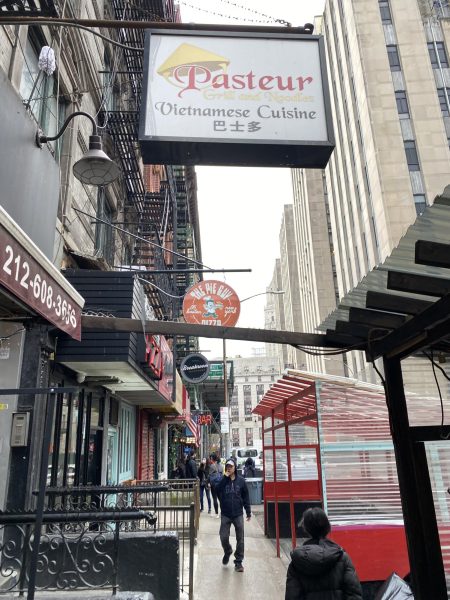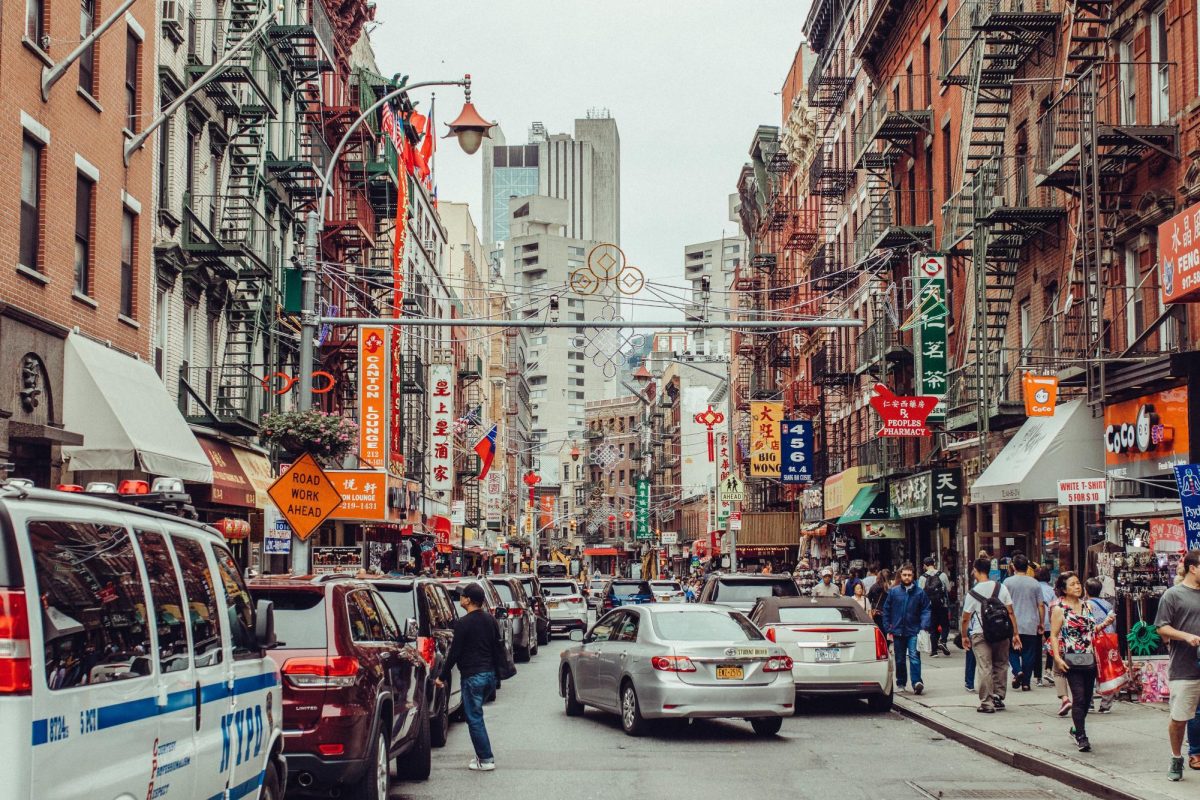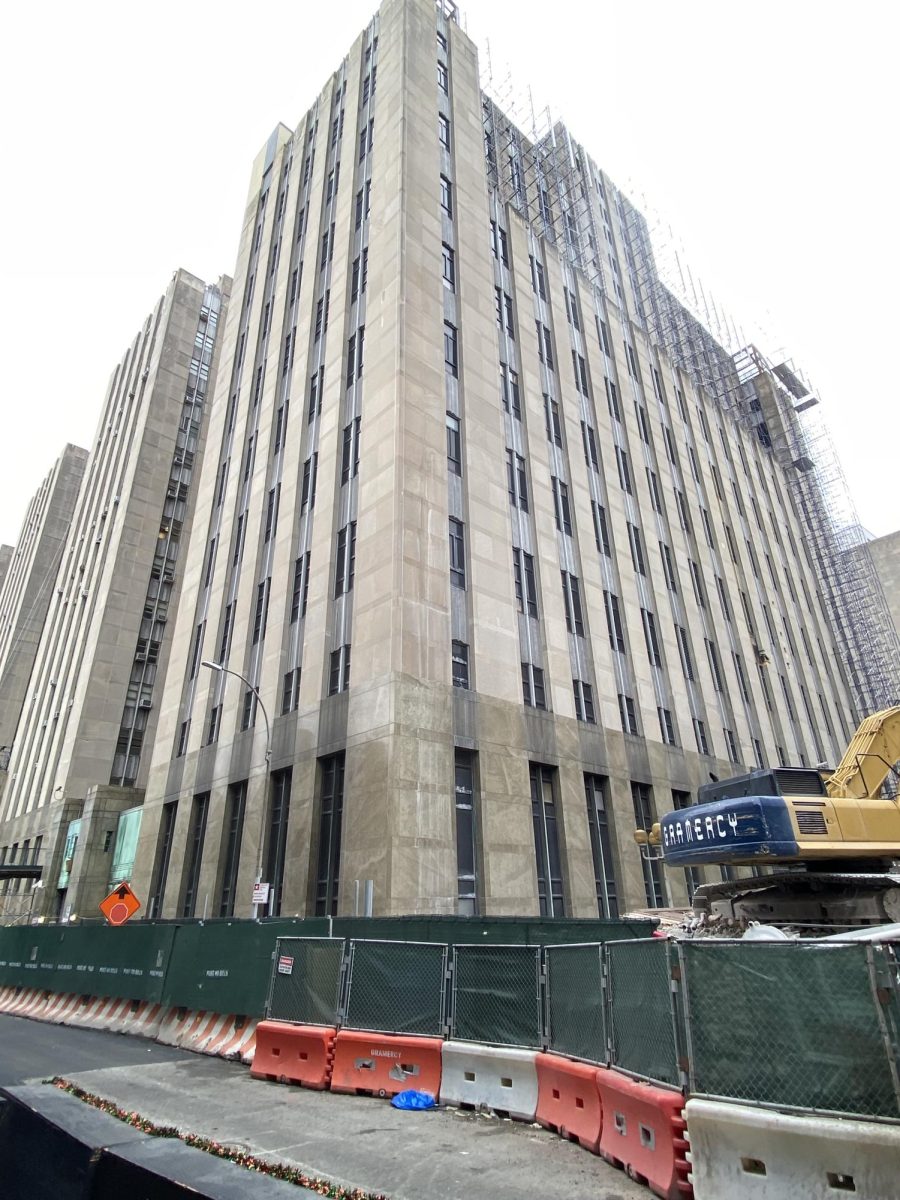Elderly grandmas inspect produce, gently flicking their pointer finger against apples in order to judge how crispy the insides are. Women sell fake Gucci wallets and bags on the sidewalk. People hand out flyers advertising miscellaneous community groups by the marketplace. 99-cent stores display racks of New York tourist merchandise and sundry plastic toys.
On the corner of Hester and Elizabeth Street in Manhattan, a line quickly forms in front of a silvery food cart, as steam bellows from the windows. The owner of the food cart has been here for years, selling Chinatown’s comfort food to passers-by and giving Chinese Americans a nostalgic taste of home.
This street food cart, Cheong Fun Cart, is one of the best places in New York City to buy steamed rice noodle rolls, a classic Cantonese dish known as Cheong Fun. The sign with a price list reads “Hand Craft Rice Rolls,” listing menu items in Chinese characters and recently, in English as well. The silky smooth noodles wrap fillings that include options such as roast pork, beef, and dried shrimp. The various types of noodles range from $1.50 to $6.00 depending on the size and the type of filling.
As the wave of second generation Chinese Americans grow up in Manhattan’s Chinatown, they frequent nostalgic eateries such as the iconic Cheong Fun cart from their childhoods.
Chinatown in 2024 is home to everything from luxury jewelry stores to hole-in-the-wall restaurants packed with locals. Chinatown in Manhattan is touted as one of the city’s most vibrant ethnic enclaves. Chinese people from all across the five boroughs come to Chinatown to taste its traditional egg tarts from Chinese bakeries and to listen to erhu instruments. Chinese grandparents come to play cards in the park.
The city knows it, and locals love it.
Recently, Chinatown’s charm has captivated the attention of non-Chinese groups, ushering cultural diffusion. This cross-cultural pollination has boosted Chinatown’s economy and opened its doors to non-Chinese populations.
However, the cultural hub has also begun showing signs of gentrification.
Many residents of Manhattan’s Chinatown along with protesters have pointed fingers at the Museum of Chinese in America (MOCA) and Jonathan Chu, MOCA’s Co-Chair. Chu doubly serves as Managing Director for the private real estate company, Chu Enterprises that has been in the family for three generations.
Chu Enterprises is one of, if not the biggest landlord in Chinatown.
Chu Enterprises was the former landlord for the Jing Fong restaurant at 88 East Broadway mall. At its peak, Jing Fong was Chinatown’s largest dim sum restaurant, frequently hosting weddings, banquets, or the regular weekend family lunch.
It was an impressive space, seating up to 800 persons in the dining hall. The restaurant was the heart of Chinatown and generated foot traffic to the neighboring stores.
During the Coronavirus pandemic, however, the restaurant’s grand dining hall held more staff members than customers and sales were down 85%, according to the third-generation Jing Fong owner Truman Lam.
They were forced to shut down. Many Jing Fong workers and allies began protesting against MOCA, accusing Chu and his company of displacing the restaurant.
Chu claimed that Jing Fong “hasn’t paid a dime” in rent for the past 12 months prior to their eviction.
To add fuel to the fire, MOCA is also being criticized for supporting the construction of a mega-jail in Chinatown.
During his term, former Mayor de Blasio proposed the development of ‘skyscraper jails,’ to replace the decrepit, controversial Riker’s Island – the current jail for the majority of New York convicts. To get rid of the major complex, however, would require building jails strung across the four boroughs.
At an estimated 300 feet tall, the mega-jail planned for Chinatown has faced great backlash from the small businesses and people in the Chinatown community. The mega-jail would be the tallest jail in the world, smack in the middle of the beloved cultural haven.
The city distributed $50 million to community institutions near the proposed jail sites as “community investments.”
This is the largest amount of money received by any institution among all the boroughs. Residents were shocked that a private museum received such a ludicrous amount of money, and even more so that MOCA compliantly accepted it.
The mega-jail would likely desert Chinatown residents – no one wants to live near a jail – and worsen foot traffic for surrounding small businesses. While MOCA claims they were not involved in city discussions regarding the jail, they said they could not afford to turn down the offer.
The mega-jail is across the street from my dentist’s office.

On a recent appointment, I saw the metal sinews and poles towering above the corner of White Street and Walker Street. The surrounding area was inconspicuously Chinatown: a Chinese bakery, a Dunkin’ Donuts, and our family dentist’s office, where we have gone for years.
The new mega-jail construction expands upon a preexisting detention center known as ‘The Tombs.’ In earnest, I never noticed ‘The Tombs’ jail lurking in the neighborhood, but as it is being expanded, the construction looks down on small businesses and pedestrians. The liveliness of the adjacent streets is utterly dampened by the dull, stiff, alienated jail under construction.
I walked around the perimeter of the construction site. Small businesses, restaurants, and bars were practically subjects of the lording mega-jail looming across the street. It was infuriating.
The mega-jail is not located in some desolate part of Chinatown. The soon-to-be tallest jail in the world is situated mere blocks away from the heart of Chinatown.
In response to MOCA’s compliance with jail construction, social advocacy organizations such as Youth Against Displacement (Instagram: @youth_against_displacement) have started organizing picketing lines outside of the museum on Thursdays through Sundays from 11 a.m. to 2 p.m., holding signs that read “Boycott MOCA” or “Museum of Corrupt Asians.”
“One of my friends told us about the group and we made signs and picketed. And we were handing out flyers inside,” said Shafakat Sahil ’24 who attended one of the picket lines.
From former Jing Fong employees to high schoolers taking to the streets, MOCA has a lot to explain.
“People don’t understand why they’re angry sometimes, right? And they’re looking for a target,” said museum president Nancy Yao Maasbach, claiming the protesters were scapegoating MOCA for Chinatown’s grievances.
Youth Against Displacement hosted workshops for the annual Chinatown Beautification Event, which I was fortunate enough to attend. At the event, youth from across the city learned about Jing Fong’s erasure, the mega-jail, and MOCA’s involvement.
The presenters specifically touched on the domino effect of gentrification: one luxury development will jack up rent prices for neighboring small businesses and residents. In turn, the spike in rent prices will drive out current residents, while attracting even more luxury housing and high-end stores.
At its heart, luxury developments do not appeal to Chinatown’s working class residents.
MOCA and Jonathan Chu still insist they are not responsible for evicting Jing Fong or for supporting the city’s proposed mega-jail, despite being the landlords of 88 East Broadway and accepting millions of dollars from the mega-jail community fund.
The development-craze in Chinatown is a domino effect: building just one luxury housing complex spurs rent increases in the surrounding area and attracts more luxury shopping outlets and hotels, none of which caters to Chinatown residents.
Youth Against Displacement has collected over 10,000 signatures in support of the Chinatown Working Group Plan to be passed. The community-led rezoning plan proposes caps on the heights of new buildings and requires affordable housing that matches the income bracket of current residents to disincentive luxury developers from encroaching.
For the most part, Chinese civic associations who own many Chinatown properties have fended off the lurching hands of luxury developers. The associations have generational roots in Chinatown, with some dating back to the days of the Chinese Exclusion Acts of 1882 when they were formed to create a community space for Chinese immigrants.
During the COVID-19 pandemic, some associations were lenient with small businesses and tenants, lowering rent prices in the face of hard economic times. Foreign developers seeking profits would not be as forgiving.
Long-standing members of the associations are growing old, forcing them to relinquish control to younger generations to manage, or worse, selling them to outside developers. Their Chinatown properties are a stake in their cultural inheritance, symbolizing the community and sacrifices of predecessors, so many owners are wary of selling to outside developers.
The fears of civic associations proved valid.
Many developers have eyed Chinatown as one of the last places in the city to develop and get a hot economic return on. It is one of the last places in the city to be gentrified.
In 2008, the City Council passed a rezoning plan in the East Village and the Lower East Side to place a cap on the height of new developments, allow affordable housing, and to preserve “neighborhoods with special character.”
Chinatown was excluded from the rezoning plan. Chinatown and Bowery residents commented on the discriminatory race lines regarding the plan. While the predominantly wealthy, white East Village residents were shielded from skyscraper connoisseurs, Chinatown was left up-for-grabs for luxury developers.
With the recent trend in “Stop Asian Hate” movements, such developments in Chinatown come with a hint of irony.
In recent years, luxury developers have staked out plans for building skyscrapers towering at 60-70 stories to house hundreds of apartments. The rise of luxury skyscrapers leaves little room for affordable housing, especially in a region historically associated with working-class immigrants and elderly residents.
As per the rezoning act, developers are restricted from building high-rise buildings, so Chinatown and the surrounding region have become the next site of gentrification. Starrett Corporation, Michael Stern’s JDS Development, the CIM Group, and L+M Development Partners made plans for four towers collectively in the Two Bridges neighborhood.
However, these plans have been thwarted by protestors claiming the towers violate the “Green Amendment,” which protects citizens’ constitutional right to a healthy environment and clean air. The Lower East Side Organizing Neighbors (LESON), an advocacy group led by local residents, has demanded a full comprehensive evaluation of the environmental impact of the four approved megatowers. In 2019, Youth Against Displacement, LESON, and others sued the city for illegally approving construction for the four towers.
As a wave of gentrification rolls over the city, Chinatown resident’s housing rights are being encroached upon, targeting elderly citizens and minority groups unable to afford high rent prices.
If this pattern continues, there will be no more Chinese elderly residents playing cards in the park on Saturday afternoons, no more Chinese adults who can afford to live in their childhood hometown, and no more children enjoying Cheong Fun.
Chinatown is the outpouring of blood, sweat, and tears from Chinese immigrants over the past century. It has served as a safe haven for Asian immigrants across Taiwan, Vietnam, Malaysia, and other Asian countries; it is still a striking symbol of Asian American identity.
This is not a lofty news article about a faraway land.
This is my Chinatown in Manhattan. Perhaps, this is your Chinatown.
Change must happen, but the question remains: at what cost and on whose terms?
You can join Youth Against Displacement at their picket lines on Thursdays through Sundays from 11 a.m. to 2 p.m.
Chinatown is the outpouring of blood, sweat, and tears from Chinese immigrants over the past century. It has served as a safe haven for Asian immigrants across Taiwan, Vietnam, Malaysia, and other Asian countries; it is still a striking symbol of Asian American identity.


